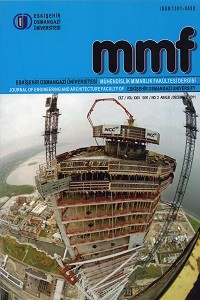Research Article
Year 2011,
Volume: 24 Issue: 2, 167 - 182, 30.12.2011
Abstract
Meerschaum is white claylike mineral of hydrous magnesium silicate. It has an irregular and white colored crystalline structure. It is wet and moisturized under soil and so it is in an easy-toprocess after extraction. Wastes are stored in a dry environment and kept ready-to-use form. While processing meerschaum %15-40 of its amount becomes waste. In this study meerschaum waste is used as aggregate in concrete, and the stress-strain diagrams for these concrete specimens are obtained. Also stress-strain diagrams of these concrete specimens are examined. It is concluded that meerschaum waste can be used as aggregate in concrete.
References
- [1] E. Sabah ve M.S. Çelik, “Sepiyolit: özellikleri ve kullanõm alanlarõ”, 3. Endüstriyel Hammaddeler Sempozyumu, 1999, ss. 132-146.
- [2] W.E. Petrascheck, “Meerschaum mines around Eskisehir district”, General Directorate of Mineral Research and Exploration Magazine, No. 61, Ankara, 1963.
- [3] H. Arik, S. Kadir, S. Saritas, “Investigation of the structural transformation and refractory properties of the brown sepiolite due to the heating at various temperatures”, Turk. J. Eng. Environ. Sci. Vol. 20, No.4, pp. 233– 244, 1996.
- [4] Y. Sarikaya, A. Yucel, O. Egilmez, G. Makul, I. Harman ve I. Bozdogan, “Using the meerschaum chips in the cigarettes as an fume filter”, National Clay Symposium Proceedings, Ankara, 1985, pp. 521-528.
- [5] M. Yeniyol ve O. Oztunali, “The mineralogy and formation of Yunak sepiolite” National Clay Symposium Proceeding, Ankara 1985, pp. 171-186.
- [6] TIT, “Utilization of Sepiolitic and Mg-Bearing Clays in Turkey”, General Directorate of Mineral Research and Exploration MTA-GIRIN Report of the research project, 314 s., MTA Library, Ankara, 1993.
- [7] E. Galan ve A. Ferrero, “Palygorskite-Sepiolite clays of Lebrija Southern Spain”, Clay Clay Miner., Vol. 30, No.3, pp.191-199, 1982.
- [8] O. Akinci, “Geology and layered meerschaum formations in 124-C1 section of Eskiúehir map”, General Directorate of Mineral Research and Exploration, Ankara, 1998, ss. 215-224.
- [9] N. Tasligil and G. Sahin, “The natural and cultural features of meerschaum”, The Journal of International Social Research, Vol. 4, No. 16, pp. 436-452, 2011. [10] K. Brauner, & A. Preisinger, “Struktur und Entstehung des Sepioliths”, Tschermaks Mineralogische und Petrographische Mitteilungen. Bb. 6, pp. 120-140, 1958.
- [11] http://www.dpu.edu.tr/akademik/fakulteler/f12/20/
- [12] Turkish Standart (TS3624), “Test method for determination the specific gravity the absorbtion water and the void ratio in hardened concrete”, Ankara, Turkey,1981.
- [13] EUROCODE 2., “Design of Concrete Structures, Part I, General Rules and Rules for Buildings”, 1991.
- [14] M. Sargin, “Solid Mechanics Divisions”, University of Waterloo, Waterloo, Ontario, Canada, 167 p, 1971. [15] D. C. Kent and R. Park, “Flexural members with confined concrete”, J. Struct. Div., ASCE, Vol. 97, No. ST7, pp. 1969-1990, 1971.
Year 2011,
Volume: 24 Issue: 2, 167 - 182, 30.12.2011
Abstract
Meerschaum is white claylike mineral of hydrous magnesium silicate. It has an irregular and white colored crystalline structure. It is wet and moisturized under soil and so it is in an easy-toprocess after extraction. Wastes are stored in a dry environment and kept ready-to-use form. While processing meerschaum %15-40 of its amount becomes waste. In this study meerschaum waste is used as aggregate in concrete, and the stress-strain diagrams for these concrete specimens are obtained. Also stress-strain diagrams of these concrete specimens are examined. It is concluded that meerschaum waste can be used as aggregate in concrete.
References
- [1] E. Sabah ve M.S. Çelik, “Sepiyolit: özellikleri ve kullanõm alanlarõ”, 3. Endüstriyel Hammaddeler Sempozyumu, 1999, ss. 132-146.
- [2] W.E. Petrascheck, “Meerschaum mines around Eskisehir district”, General Directorate of Mineral Research and Exploration Magazine, No. 61, Ankara, 1963.
- [3] H. Arik, S. Kadir, S. Saritas, “Investigation of the structural transformation and refractory properties of the brown sepiolite due to the heating at various temperatures”, Turk. J. Eng. Environ. Sci. Vol. 20, No.4, pp. 233– 244, 1996.
- [4] Y. Sarikaya, A. Yucel, O. Egilmez, G. Makul, I. Harman ve I. Bozdogan, “Using the meerschaum chips in the cigarettes as an fume filter”, National Clay Symposium Proceedings, Ankara, 1985, pp. 521-528.
- [5] M. Yeniyol ve O. Oztunali, “The mineralogy and formation of Yunak sepiolite” National Clay Symposium Proceeding, Ankara 1985, pp. 171-186.
- [6] TIT, “Utilization of Sepiolitic and Mg-Bearing Clays in Turkey”, General Directorate of Mineral Research and Exploration MTA-GIRIN Report of the research project, 314 s., MTA Library, Ankara, 1993.
- [7] E. Galan ve A. Ferrero, “Palygorskite-Sepiolite clays of Lebrija Southern Spain”, Clay Clay Miner., Vol. 30, No.3, pp.191-199, 1982.
- [8] O. Akinci, “Geology and layered meerschaum formations in 124-C1 section of Eskiúehir map”, General Directorate of Mineral Research and Exploration, Ankara, 1998, ss. 215-224.
- [9] N. Tasligil and G. Sahin, “The natural and cultural features of meerschaum”, The Journal of International Social Research, Vol. 4, No. 16, pp. 436-452, 2011. [10] K. Brauner, & A. Preisinger, “Struktur und Entstehung des Sepioliths”, Tschermaks Mineralogische und Petrographische Mitteilungen. Bb. 6, pp. 120-140, 1958.
- [11] http://www.dpu.edu.tr/akademik/fakulteler/f12/20/
- [12] Turkish Standart (TS3624), “Test method for determination the specific gravity the absorbtion water and the void ratio in hardened concrete”, Ankara, Turkey,1981.
- [13] EUROCODE 2., “Design of Concrete Structures, Part I, General Rules and Rules for Buildings”, 1991.
- [14] M. Sargin, “Solid Mechanics Divisions”, University of Waterloo, Waterloo, Ontario, Canada, 167 p, 1971. [15] D. C. Kent and R. Park, “Flexural members with confined concrete”, J. Struct. Div., ASCE, Vol. 97, No. ST7, pp. 1969-1990, 1971.
There are 13 citations in total.
Details
| Subjects | Civil Engineering |
|---|---|
| Journal Section | Research Articles |
| Authors | |
| Publication Date | December 30, 2011 |
| Acceptance Date | October 25, 2011 |
| Published in Issue | Year 2011 Volume: 24 Issue: 2 |


